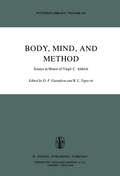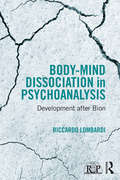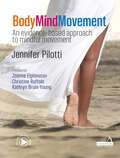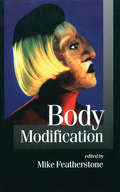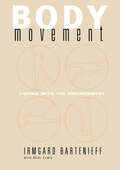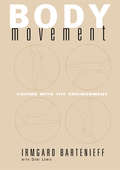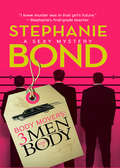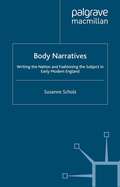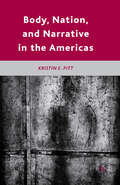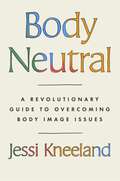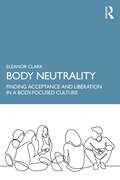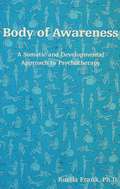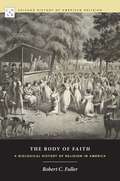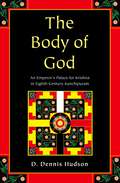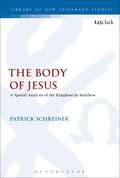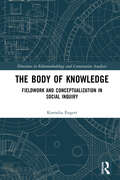- Table View
- List View
Body, Mind, and Method: Essays in Honor of Virgil C. Aldrich (Synthese Library #138)
by Donald F. Gustafson and Bangs L. TapscottSimple seeing. Plain talking. Language in use and persons in action. These are among the themes of Virgil Aldrich's writings, from the 1930's onward. Throughout these years, he has been an explorer of conceptual geography: not as a foreign visitor studying an alien land, but close up 'in the language in which we live, move, and have our being'. This is his work. It is clear to those who know him best that he also has fun at it. Yet, in the terms of his oft-cited distinction, it is equally clear that he is to be counted not among the funsters of philosophy, but among its most committed workers. Funsters are those who attempt to do epistemology, metaphysics, or analysis by appealing to examples which are purely imaginary, totally fictional, as unrealistic as you like, 'completely unheard of'. Such imaginative wilfullness takes philosophers away from, not nearer to, 'the rough ground' (Wittgenstein) where our concepts have their origin and working place. In the funsters' imagined, 'barely possible' (but actually impossible) world, simple seeing becomes transformed into the sensing of sense-data; plain talk is rejected as imprecise, vague, and misleading; and per sons in action show up as ensouled physical objects in motion. Then the fly is in the bottle, buzzing out its tedious tunes: the problem of perception of the external world; the problem of meaning and what it is; the mind-body problem. Image-mongering has got the best of image-management.
Body-Mind Dissociation in Psychoanalysis: Development after Bion (Relational Perspectives Book Series)
by Riccardo LombardiThe conflict and dissociation between the Body and the Mind have determinant implications in the context of our current clinical practice, and are an important source of internal and relational disturbances. Body-Mind Dissociation in Psychoanalysis proposes the concept as a new hypothesis, different from traumatic dissociation or states of splitting. This approach opens the door to a clinical confrontation with extreme forms of mental disturbance, such as psychosis or borderline disorders, and strengthens the relational power of the analytic encounter, through a focus on the internal sensory/emotional axis in both analyst and analysand. The book details this importance of the analyst’s intrasubjective relationship with the analysand in constructing new developmental horizons, starting from the body-mind exchange of the two participants. Body-Mind Dissociation in Psychoanalysis will be of use to students, beginners in psychotherapy, mental health practitioners and seasoned psychoanalysts.
Body-Mind Dissociation in Psychoanalysis: Development after Bion (Relational Perspectives Book Series)
by Riccardo LombardiThe conflict and dissociation between the Body and the Mind have determinant implications in the context of our current clinical practice, and are an important source of internal and relational disturbances. Body-Mind Dissociation in Psychoanalysis proposes the concept as a new hypothesis, different from traumatic dissociation or states of splitting. This approach opens the door to a clinical confrontation with extreme forms of mental disturbance, such as psychosis or borderline disorders, and strengthens the relational power of the analytic encounter, through a focus on the internal sensory/emotional axis in both analyst and analysand. The book details this importance of the analyst’s intrasubjective relationship with the analysand in constructing new developmental horizons, starting from the body-mind exchange of the two participants. Body-Mind Dissociation in Psychoanalysis will be of use to students, beginners in psychotherapy, mental health practitioners and seasoned psychoanalysts.
Body Mind Movement: An evidence-based approach to mindful movement
by Jennifer PilottiBody Mind Movement: An Evidence-Based Approach to Mindful Movement explores the foundational concepts behind the science of learning, motor control, and body awareness. The book features case studies, exercises to illustrate the concepts, and opportunities for critical thinking, allowing movement professionals not only to understand the science behind why techniques and modalities work, but also to explore ways of implementing these approaches with their patients.The work is written for the curious movement professional who wants to enhance their ability to work with students of all ages and abilities.To learn more about Jenn's in-person workshops and retreats, please visit www.jennpilotti.com
Body Modification
by Mike FeatherstoneThis fascinating collection explores the growing range of body modification practices such as piercing, tattooing, branding, cutting and inserting implants, which have sprung up recently in the West. It asks whether this implies that we are returning to traditional tribal practices of inscribing identities onto bodies on the part of 'modern primitives', or is body modification better understood as purely cosmetic and decorative with body markings merely temporary signs of transferable loyalties?
Body Modification (PDF)
by Mike FeatherstoneThis fascinating collection explores the growing range of body modification practices such as piercing, tattooing, branding, cutting and inserting implants, which have sprung up recently in the West. It asks whether this implies that we are returning to traditional tribal practices of inscribing identities onto bodies on the part of 'modern primitives', or is body modification better understood as purely cosmetic and decorative with body markings merely temporary signs of transferable loyalties?
Body Movement: Coping with the Environment
by Irmgard Bartenieff Dori Lewis"'Irmgard Bartenieff has a profound knowledge of the human body and how it moves. I am delighted that this will now be made available to many more people.'." -- George Balanchine of Director, New York City Ballet"'Irmgard Bartenieff's pioneering work in the multiple applications of Labananalysis has had a transforming influence on many areas of movement training. Her careful and detailed development of the spatial principles into active corrective work has illuminated and altered the training of people as varied as dancers, choreographers, physical therapists, movement and dance therapists, and psychotherapists. Anthropologists and non-verbal communication researchers have found their world view necessarily altered by her fundamental innovations. The field of body/mind work will need to adapt to include her clear working through of basic principles.'." -- Kayla Kazahn Zalk of President, American Dance Guild
Body Movement: Coping with the Environment
by Irmgard Bartenieff Dori Lewis"'Irmgard Bartenieff has a profound knowledge of the human body and how it moves. I am delighted that this will now be made available to many more people.'." -- George Balanchine of Director, New York City Ballet"'Irmgard Bartenieff's pioneering work in the multiple applications of Labananalysis has had a transforming influence on many areas of movement training. Her careful and detailed development of the spatial principles into active corrective work has illuminated and altered the training of people as varied as dancers, choreographers, physical therapists, movement and dance therapists, and psychotherapists. Anthropologists and non-verbal communication researchers have found their world view necessarily altered by her fundamental innovations. The field of body/mind work will need to adapt to include her clear working through of basic principles.'." -- Kayla Kazahn Zalk of President, American Dance Guild
Body Narratives: Writing the Nation and Fashioning the Subject in Early Modern England
by S. ScholzBody Narratives deals with the configurations in the literature and culture of sixteenth-century England. It investigates the relationship between disciplinary discourses of the human body and political body imagery in the texts of courtly writers like Spenser, Sidney, Ralegh and others, and traces its interdependence in their narratives of national identity, imperial expansion and gender difference.
Body, Nation, and Narrative in the Americas
by K. PittThis book contextualizes 21st century representations of disappearance, torture, and detention within a historical framework of inter-American narratives. Examining a range of sources, Pitt finds a persistent focus on the body that links contemporary practices of political terror to concerns about corporality and sovereignty.
Body Neutral: A revolutionary guide to overcoming body image issues
by Jessi KneelandA life-changing guide to reclaiming your relationship with your body and yourselfHave you ever thought that if only you could change the way you looked, your life would be better? It's so easy to imagine that by changing the outside of our bodies, we'd feel better on the inside. But we all know that even if we could magically attain a so-called 'perfect' body, our problems wouldn't actually be solved. That's because body image issues are never just about the body: they're always about something deeper inside.As a longtime personal trainer and coach, Jessi Kneeland has seen hundreds of clients achieve their fitness goals but still feel trapped in a web of body hatred, anxiety, obsession and dysmorphia. Searching for a solution, Kneeland set out on a quest to discover what it truly takes to help people understand, process and heal their body image issues for good. They share their discoveries in Body Neutral, where you'll learn:* The power of 'body neutrality' - the ability to accept and respect your body, even if it isn't the way you'd prefer it to be.* Which of the four 'body image avatars' - each of which represents a different root cause for body image issues - aligns with you and your relationship with your body: the self-objectifier, the high achiever, the outsider or the runner.* Actionable and unique methods to help you strip away the layers of false meaning, excess power, moral significance and shame that has been preventing you from both connecting to and appreciating your body and feeling truly worthy as a person.There is a reason you're unhappy with your body, and Body Neutral will help you discover what that reason is and how to defuse its power, freeing you to enjoy a life of true confidence, security and satisfaction.
Body Neutrality: Finding Acceptance and Liberation in a Body-Focused Culture
by Eleanor ClarkThis practical, accessible book teaches readers how to practice healthy body image habits and let go of an emphasis on body image through research, activities, and personal stories. Body neutrality is a body image approach focused on finding acceptance and liberation from the body-focused culture in which we live. Body neutrality is a shift toward seeing our bodies as a vessel of who we are rather than as who we are. This guide is organized into thirteen chapters, each outlining a different concept of body neutrality ranging from comparison and identity to mindfulness and gratitude, inviting participation from the reader through end-of-chapter activities. For anyone aiming to release the enslaving emphasis placed on appearance in a world where body obsession has become inappropriately “normal,” this book will provide insight and practical guidance toward freedom. Body Neutrality is for anyone struggling with self-esteem and body image issues who aims for acceptance and liberation.
Body Neutrality: Finding Acceptance and Liberation in a Body-Focused Culture
by Eleanor ClarkThis practical, accessible book teaches readers how to practice healthy body image habits and let go of an emphasis on body image through research, activities, and personal stories. Body neutrality is a body image approach focused on finding acceptance and liberation from the body-focused culture in which we live. Body neutrality is a shift toward seeing our bodies as a vessel of who we are rather than as who we are. This guide is organized into thirteen chapters, each outlining a different concept of body neutrality ranging from comparison and identity to mindfulness and gratitude, inviting participation from the reader through end-of-chapter activities. For anyone aiming to release the enslaving emphasis placed on appearance in a world where body obsession has become inappropriately “normal,” this book will provide insight and practical guidance toward freedom. Body Neutrality is for anyone struggling with self-esteem and body image issues who aims for acceptance and liberation.
Body of Awareness: A Somatic and Developmental Approach to Psychotherapy
by Ruella FrankMerging scientific theory with a practical, clinical approach, Body of Awareness explores the formation of infant movement experience and its manifest influence upon the later adult. Most significantly, it shows how the organizing principles in early development are functionally equivalent to those of the adult. It demonstrates how movement plays a critical role in a developing self-awareness for the infant and in maintaining a healthy self throughout life. In addition, a variety of case studies illustrates how infant developmental movement patterns are part of the moment-to-moment processes of the adult client and how to bring these patterns to awareness within therapy. Body of Awareness is intended to help therapists, new or advanced, to enhance their skills of attunement. They can do this by heightening their observations of subtle movement patterns as they emerge within the client/therapist relationship, and by respective their own developing feelings within session as essential information to the therapy process. And as developmental patterns are central to psychological functioning, a background study of movement provides the therapist with critical insight into the unfolding psychodynamic field.
Body of Awareness: A Somatic and Developmental Approach to Psychotherapy
by Ruella FrankMerging scientific theory with a practical, clinical approach, Body of Awareness explores the formation of infant movement experience and its manifest influence upon the later adult. Most significantly, it shows how the organizing principles in early development are functionally equivalent to those of the adult. It demonstrates how movement plays a critical role in a developing self-awareness for the infant and in maintaining a healthy self throughout life. In addition, a variety of case studies illustrates how infant developmental movement patterns are part of the moment-to-moment processes of the adult client and how to bring these patterns to awareness within therapy. Body of Awareness is intended to help therapists, new or advanced, to enhance their skills of attunement. They can do this by heightening their observations of subtle movement patterns as they emerge within the client/therapist relationship, and by respective their own developing feelings within session as essential information to the therapy process. And as developmental patterns are central to psychological functioning, a background study of movement provides the therapist with critical insight into the unfolding psychodynamic field.
The Body of Faith: A Biological History of Religion in America (Chicago History of American Religion)
by Robert C. FullerThe postmodern view that human experience is constructed by language and culture has informed historical narratives for decades. Yet newly emerging information about the biological body now makes it possible to supplement traditional scholarly models with insights about the bodily sources of human thought and experience. The Body of Faith is the first account of American religious history to highlight the biological body. Robert C. Fuller brings a crucial new perspective to the study of American religion, showing that knowledge about the biological body deeply enriches how we explain dramatic episodes in American religious life. Fuller shows that the body’s genetically evolved systems—pain responses, sexual passion, and emotions like shame and fear—have persistently shaped the ways that Americans forge relationships with nature, to society, and to God. The first new work to appear in the Chicago History of American Religion series in decades, The Body of Faith offers a truly interdisciplinary framework for explaining the richness, diversity, and endless creativity of American religious life.
The Body of Faith: A Biological History of Religion in America (Chicago History of American Religion)
by Robert C. FullerThe postmodern view that human experience is constructed by language and culture has informed historical narratives for decades. Yet newly emerging information about the biological body now makes it possible to supplement traditional scholarly models with insights about the bodily sources of human thought and experience. The Body of Faith is the first account of American religious history to highlight the biological body. Robert C. Fuller brings a crucial new perspective to the study of American religion, showing that knowledge about the biological body deeply enriches how we explain dramatic episodes in American religious life. Fuller shows that the body’s genetically evolved systems—pain responses, sexual passion, and emotions like shame and fear—have persistently shaped the ways that Americans forge relationships with nature, to society, and to God. The first new work to appear in the Chicago History of American Religion series in decades, The Body of Faith offers a truly interdisciplinary framework for explaining the richness, diversity, and endless creativity of American religious life.
The Body of Faith: A Biological History of Religion in America (Chicago History of American Religion)
by Robert C. FullerThe postmodern view that human experience is constructed by language and culture has informed historical narratives for decades. Yet newly emerging information about the biological body now makes it possible to supplement traditional scholarly models with insights about the bodily sources of human thought and experience. The Body of Faith is the first account of American religious history to highlight the biological body. Robert C. Fuller brings a crucial new perspective to the study of American religion, showing that knowledge about the biological body deeply enriches how we explain dramatic episodes in American religious life. Fuller shows that the body’s genetically evolved systems—pain responses, sexual passion, and emotions like shame and fear—have persistently shaped the ways that Americans forge relationships with nature, to society, and to God. The first new work to appear in the Chicago History of American Religion series in decades, The Body of Faith offers a truly interdisciplinary framework for explaining the richness, diversity, and endless creativity of American religious life.
The Body of Faith: A Biological History of Religion in America (Chicago History of American Religion)
by Robert C. FullerThe postmodern view that human experience is constructed by language and culture has informed historical narratives for decades. Yet newly emerging information about the biological body now makes it possible to supplement traditional scholarly models with insights about the bodily sources of human thought and experience. The Body of Faith is the first account of American religious history to highlight the biological body. Robert C. Fuller brings a crucial new perspective to the study of American religion, showing that knowledge about the biological body deeply enriches how we explain dramatic episodes in American religious life. Fuller shows that the body’s genetically evolved systems—pain responses, sexual passion, and emotions like shame and fear—have persistently shaped the ways that Americans forge relationships with nature, to society, and to God. The first new work to appear in the Chicago History of American Religion series in decades, The Body of Faith offers a truly interdisciplinary framework for explaining the richness, diversity, and endless creativity of American religious life.
The Body of God: An Emperor's Palace for Krishna in Eighth-Century Kanchipuram
by D Dennis HudsonThis book is the crowning achievement of the remarkable scholar D. Dennis Hudson, bringing together the results of a lifetime of interdisciplinary study of south Indian Hinduism. The book is a finely detailed examination of a virtually unstudied Tamil Hindu temple, the Vaikuntha Perumal (ca. 770 C.E.). Hudson offers a sustained reading of the temple as a coherent, organized, minutely conceptualized mandala. Its iconography and structure can be understood in the light of a ten-stanza poem by the Alvar poet Tirumangai, and of the Bhagavata Purana and other major religious texts, even as it in turn illuminates the meanings of those texts. Hudson takes the reader step by step on a tour of the temple, telling the stories suggested by each of the 56 sculpted panels and showing how their relationship to one another brings out layers of meaning. He correlates the stories with stages in the spiritual growth of the king through the complex rituals that formed a crucial dimension of the religion. The result is a tapestry of interpretation that brings to life the richness of spiritual understanding embodied in the temple. Hudson's underlying assumption is that the temple itself constitutes a summa theologica for the Pancharatra doctrines in the Bhagavata tradition centered on Krishna as it had developed through the eighth century. This tradition was already ancient and had spread widely across South Asia and into Southeast Asia. By interweaving history with artistic, liturgical, and textual interpretation, Hudson makes a remarkable contribution to our understanding of an Indian religious and cultural tradition.
The Body of Jesus: A Spatial Analysis of the Kingdom in Matthew (The Library of New Testament Studies #555)
by Patrick SchreinerLittle attention is usually given to the space or place of the kingdom. Yet Matthew employs the distinctive phrase "kingdom of heaven†? and also portrays Jesus as Immanuel (God with us). In this volume Patrick Schreiner argues that by expanding one's view of space one can see that Jesus' purpose is to reorder the space of the earth in Matthew as the heavenly king. Jesus pierces the barrier between the two realms in his incarnation, and the spaces of heaven and earth begin to collide in his ministry. Therefore, in Matthew, Jesus does not just promise a temporal or ethereal kingdom, but one that is located, one that has a sense of rootedness. Jesus is granted authority over this space and inspires people to follow him in this construction project. The spatial kingdom begins in his body, and he extends it to his church by promising his presence.
The Body of Jesus: A Spatial Analysis of the Kingdom in Matthew (The Library of New Testament Studies)
by Patrick SchreinerLittle attention is usually given to the space or place of the kingdom. Yet Matthew employs the distinctive phrase “kingdom of heaven” and also portrays Jesus as Immanuel (God with us). In this volume Patrick Schreiner argues that by expanding one's view of space one can see that Jesus' purpose is to reorder the space of the earth in Matthew as the heavenly king. Jesus pierces the barrier between the two realms in his incarnation, and the spaces of heaven and earth begin to collide in his ministry. Therefore, in Matthew, Jesus does not just promise a temporal or ethereal kingdom, but one that is located, one that has a sense of rootedness. Jesus is granted authority over this space and inspires people to follow him in this construction project. The spatial kingdom begins in his body, and he extends it to his church by promising his presence.
The Body of Knowledge: Fieldwork and Conceptualization in Social Inquiry (Directions in Ethnomethodology and Conversation Analysis)
by Kornelia EngertThis book presents a vivid and close-up view of social science researchers engaged in fieldwork, in discussions with colleagues, and in writing. Adopting an ethnographic approach inspired by ethnomethodology and conversation analysis, the author pursues a praxeological analysis of social inquiry in situ. By conceiving of analytical practices such as observation, shop talk, and conceptualization in experiential terms, the seen but unnoticed structures of knowledge work are exposed and made available for empirical analysis. In a departure from ethnographic studies of research that focus on the physical sciences, the author uses the example of sociological research to shed new light on the role of self and mind for epistemic cultures, on the elusive materiality of conceptual objects, and on researchers’ experiential ways of seizing, reviewing, and accrediting knowledge. A rich and pervasive study of elementary sites in the research process, The Body of Knowledge will appeal to scholars of sociology, anthropology, and the humanities with interests in the epistemic practice of their own discipline, as well as those working in fields such as the social study of science, ethnomethodology and conversation analysis, and the sociology of interaction.
The Body of Knowledge: Fieldwork and Conceptualization in Social Inquiry (Directions in Ethnomethodology and Conversation Analysis)
by Kornelia EngertThis book presents a vivid and close-up view of social science researchers engaged in fieldwork, in discussions with colleagues, and in writing. Adopting an ethnographic approach inspired by ethnomethodology and conversation analysis, the author pursues a praxeological analysis of social inquiry in situ. By conceiving of analytical practices such as observation, shop talk, and conceptualization in experiential terms, the seen but unnoticed structures of knowledge work are exposed and made available for empirical analysis. In a departure from ethnographic studies of research that focus on the physical sciences, the author uses the example of sociological research to shed new light on the role of self and mind for epistemic cultures, on the elusive materiality of conceptual objects, and on researchers’ experiential ways of seizing, reviewing, and accrediting knowledge. A rich and pervasive study of elementary sites in the research process, The Body of Knowledge will appeal to scholars of sociology, anthropology, and the humanities with interests in the epistemic practice of their own discipline, as well as those working in fields such as the social study of science, ethnomethodology and conversation analysis, and the sociology of interaction.
